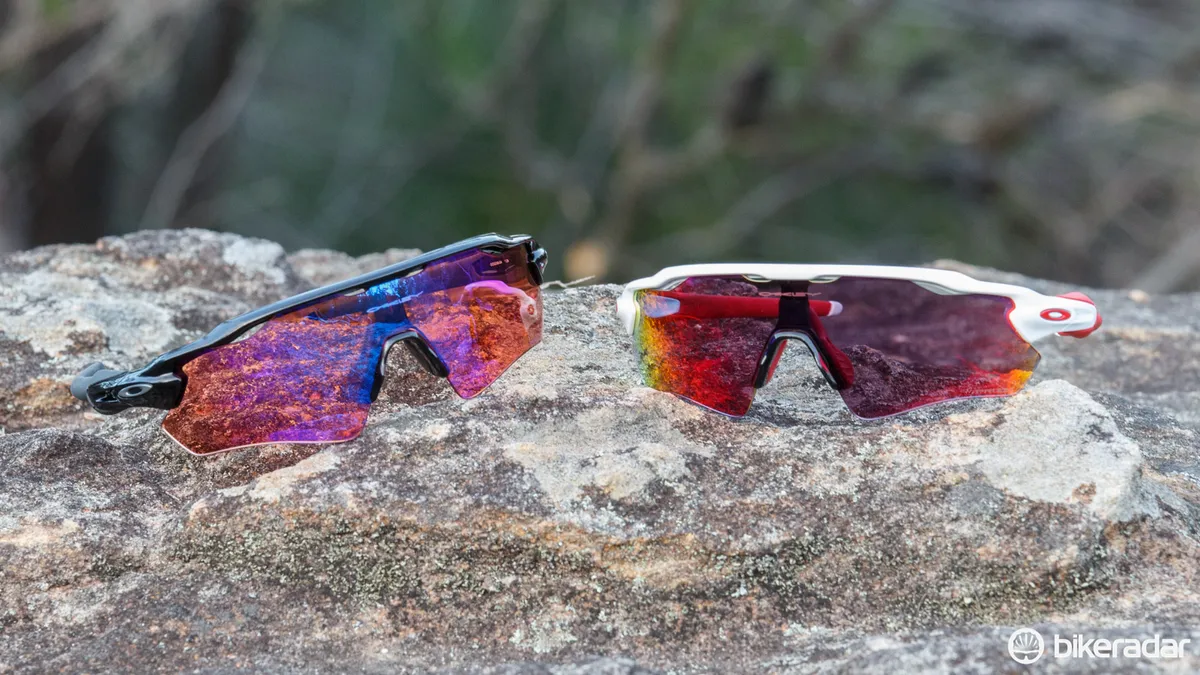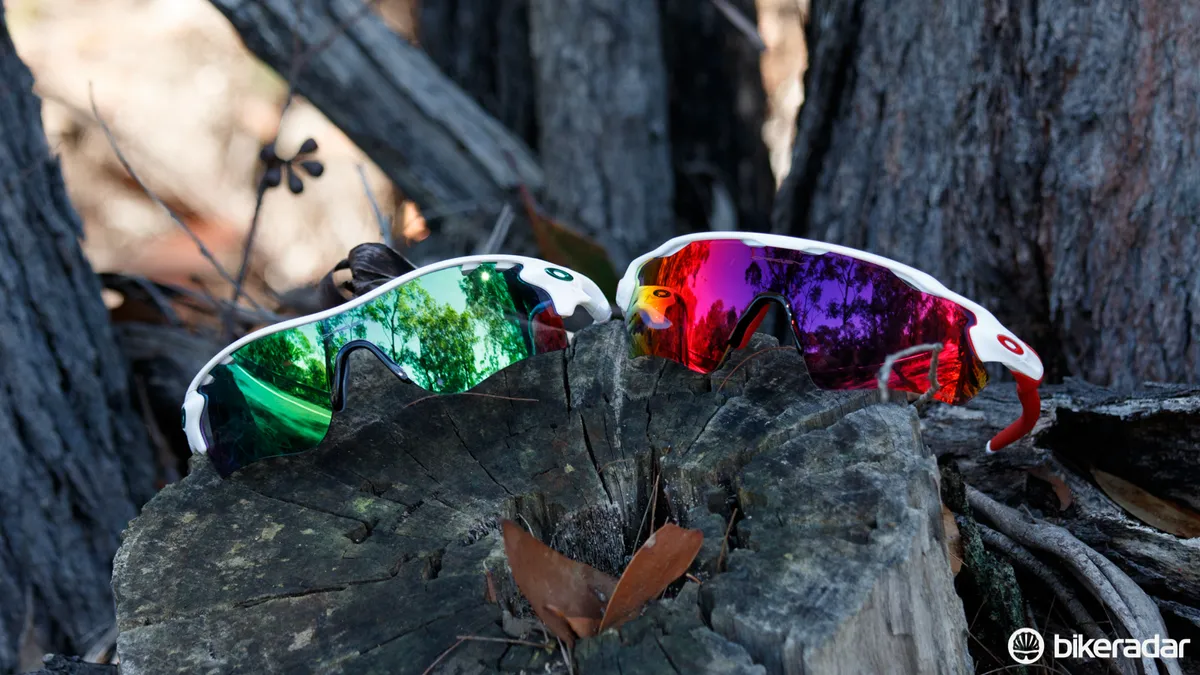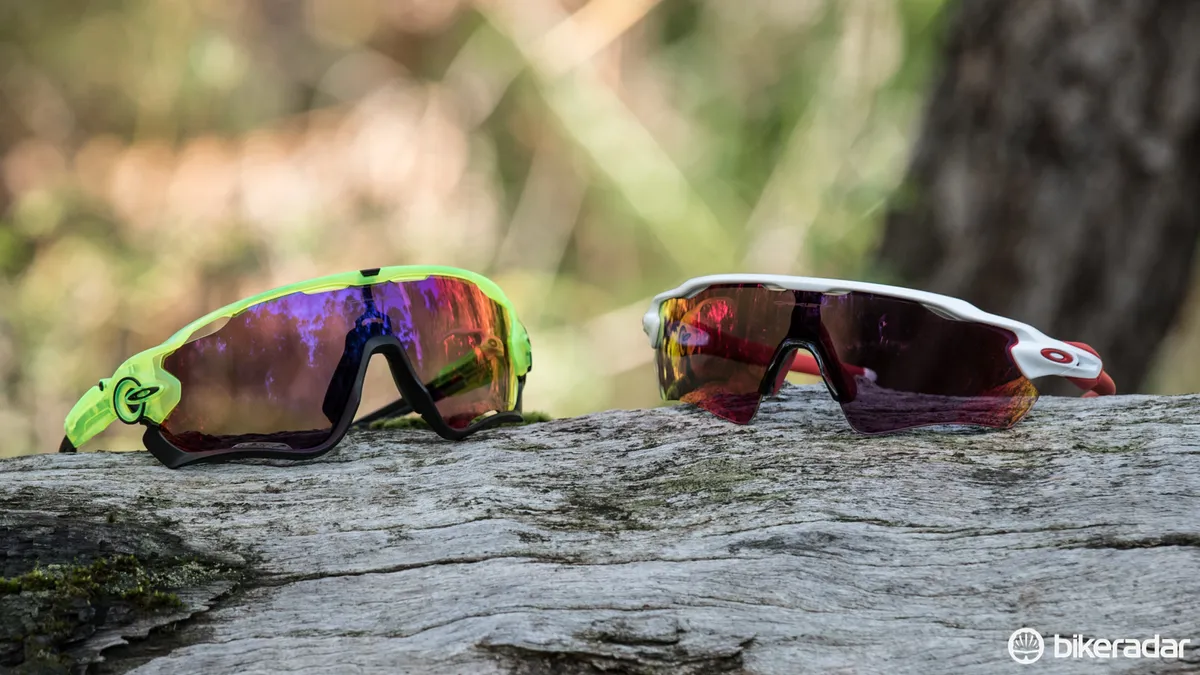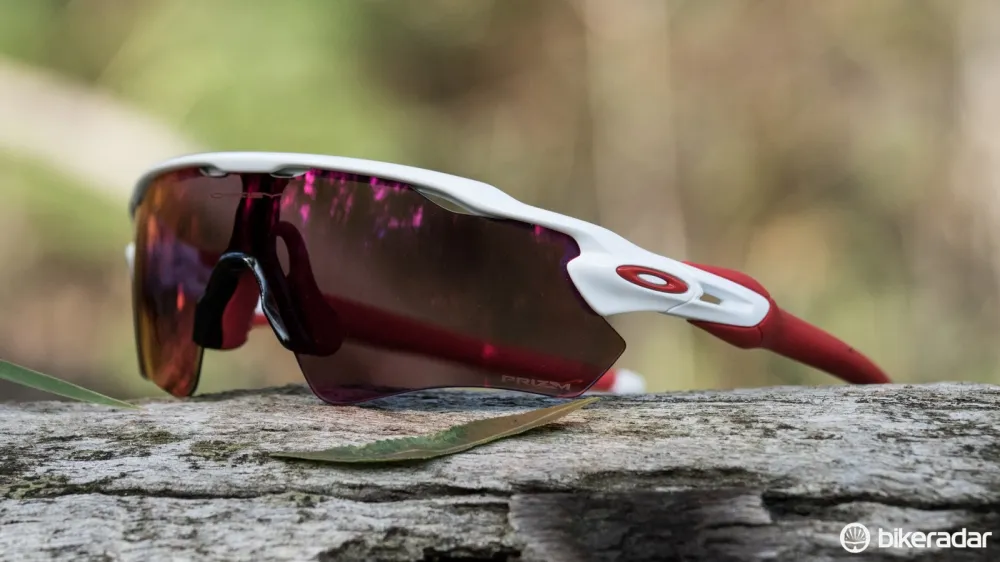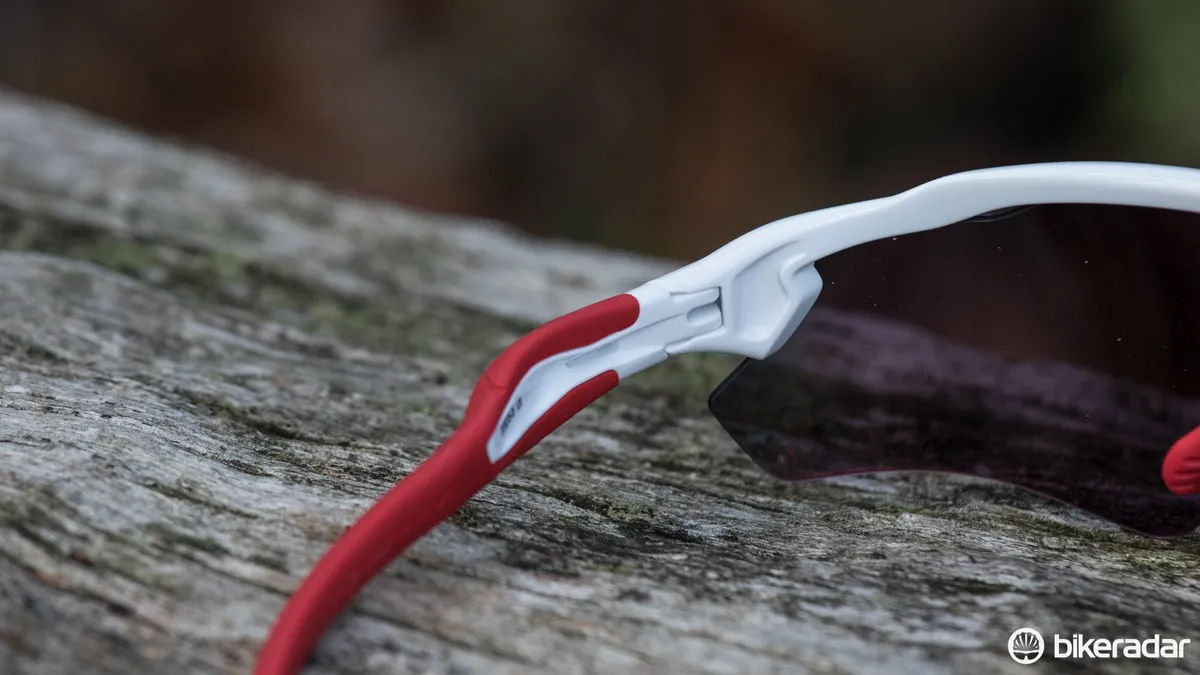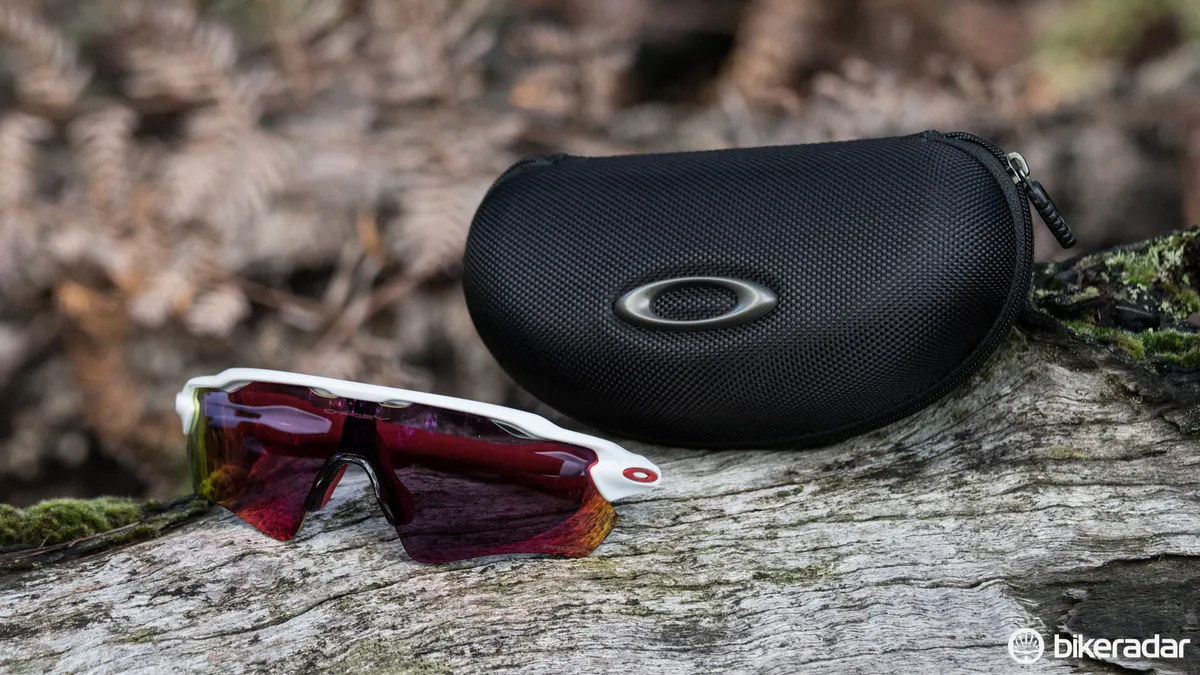Over the past decade, the Oakley Radar has arguably become the most popular set of sunglasses in cycling. And for good reason. It offers a durable and light construction that’s comfortable for a vast majority of users. That said, it’s not perfect – the long arms interfere with some helmets and upper peripheral vision can be a little lacking.
Launched in conjunction with the all-new Jawbreaker, the Radar EV is an evolution of the original Radar. Standing for ‘Expanded view’, the EVs share one of the Jawbreaker’s key features in a raised lens (approx. 5mm) at the top of the frame, providing better vision in the usual ‘head down’ position of cycling. (This raised frame is different to Oakley's Radarlock XL, which achieved greater field of vision by extending the nose piece.)
On top of this, ventilation has been improved, with the port and channeling at the arms brought forward and refined in conjunction with the new vented lens.
Lastly, Oakley’s new sport-specific ‘Prizm’ lenses were released at the same time of these glasses. Simply put, the lenses are designed to improve visibility by increasing contrast in specific conditions.
Over the past few months we’ve been testing Oakley’s cycling-specific Path Prizm Road and Trail lenses in the Oakley Radar EV glasses, along with the Jawbreakers. The Path is the smaller of two Radar EV lenses offered and tends to hug closely to ones cheekbones, with the Pitch offering expanded lower coverage and a straighter bottom edge.
- Highs: Brilliant discipline-specific vision, high comfort, durable, no fog
- Lows: Price, long arms interfere with some helmet retention systems, Hydrophobic coating on outside only
- Buy if: You’re after a high performing cycling sunglass with benchmark (environment specific) vision capabilities
Original Radar vs Radar EV
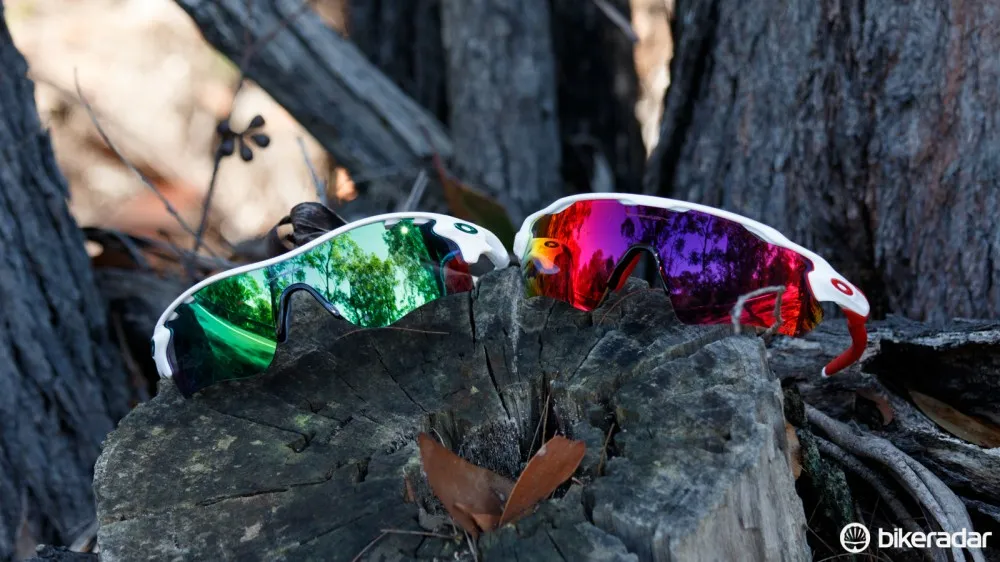
Radar EV (on right) next to the Radarlock Path
Compared with the original Radar, the EVs' fit remains extremely similar, with the same curved and lengthened arms wrapped in Oakley’s non-slip and replaceable ‘Unobtanium’ earsocks. Using the same rubber as the earsocks, a choice of two different thickness nose pads are provided to work with a variety of nose shapes. As long-time Radar users, we were extremely comfortable in the new model.
For us, the fit doesn’t pinch, nor rub anywhere it shouldn’t (such as on your ears). Even after hours of wearing them, they remain perfectly comfortable. The acid test is mountain biking, and the Radar EVs stay exactly in place without any wobble.
Although helmet designs have improved steadily to work better with sunglasses, some retention systems still come into contact with the Radar glasses' long arms. In rare cases where it’s still an issue, you can place the arms over the top of the helmet’s retention system – but it’s not ideal, as your glasses are likely to move if your helmet does.
At approximately 5mm taller than the original Radar Path, it’s impressive how much our top peripheral vision improved. We’re used to seeing a sunglasses frame in our vision when on the attack, but the Radar EV (like the Jawbreaker) provides the needed clearance.
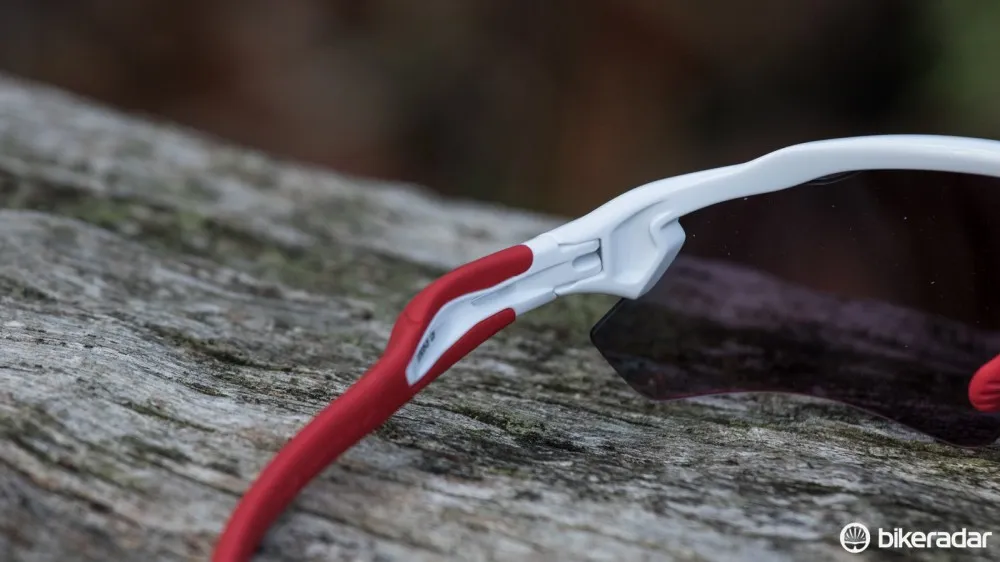
A redesigned vent port and relieved sections actually reduce weight
Despite this additional lens and frame height, the 28g Radar EV Path drops a gram compared to the original (non lock model). This surprising figure is due to a new relieved and channeled arm and pivot design.
The old Oakley Radar glasses feature an ‘O’ channel in their arms; for the EVs, this has been replaced with a more forward vent port that leads to effective channels on each arm – helping to direct airflow down past your temples and helmet straps.
Adding to this is the vented lens. This is an option with the original Radar Path lens, but the raised EV lens means these small ports are more inline with your brow instead of under. Along with wicking sweat at the brow, these certainly contribute to the complete lack of fogging experienced.
Unfortunately, the raised profile means older Radar lenses are not cross compatible with the new frame. That said, apart from having the same length arms, more limited lens options and currently no 'Radarlock' option, the new Radar EVs are an improvement on the originals in every other aspect.
Radar EV vs Jawbreaker
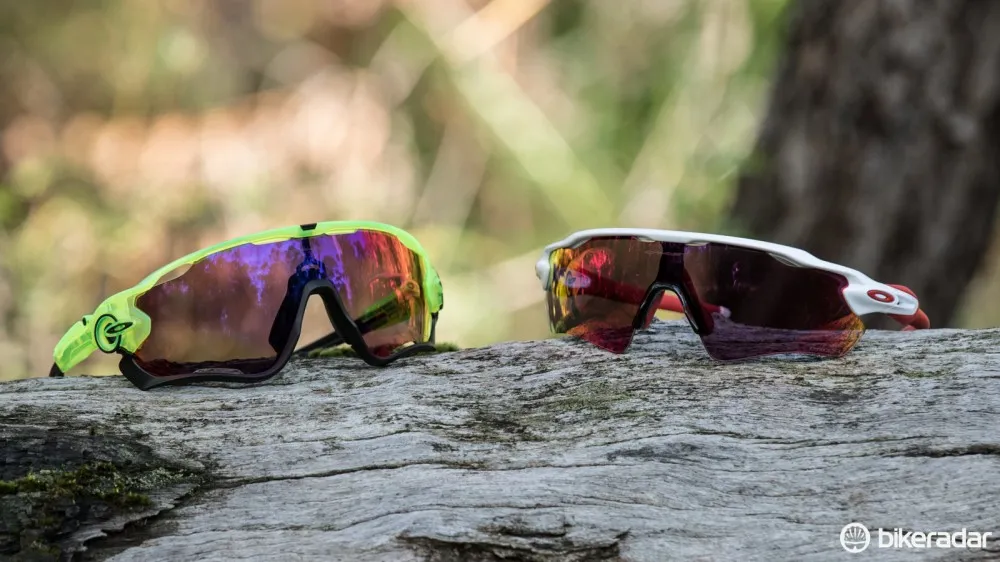
The Jawbreaker (left) is a ground-up cycling specific model
Designed in conjunction with Mark Cavendish and designed exclusively as cycling sunglasses, the more expensive Jawbreaker is the Oakley model being strongly marketed to cyclists. Being made up of 27 pieces, it’s got a whole lot more going on than the relatively simple Radar EV.
Where we complain of occasional helmet compatibility when wearing Radars, the Jawbreakers are free of any such grumbles. Small plastic arms are length-adjustable through the sliding/lock mechanism. This means the arms don’t come close to contacting helmet retention systems and allow for greater adjustment to different head shapes.
While these arms add a few components, it’s the unique ‘Switchlock’ system that really sets the Jawbreaker apart. Here, the bottom frame can be unlocked and swung out of the way for incredibly simple lens replacement.
Another benefit of this locking system is that it takes stress and flex off the lens, claiming to remove lens distortion. However, we can’t detect a difference in vision between the Radar EV and Jawbreaker.
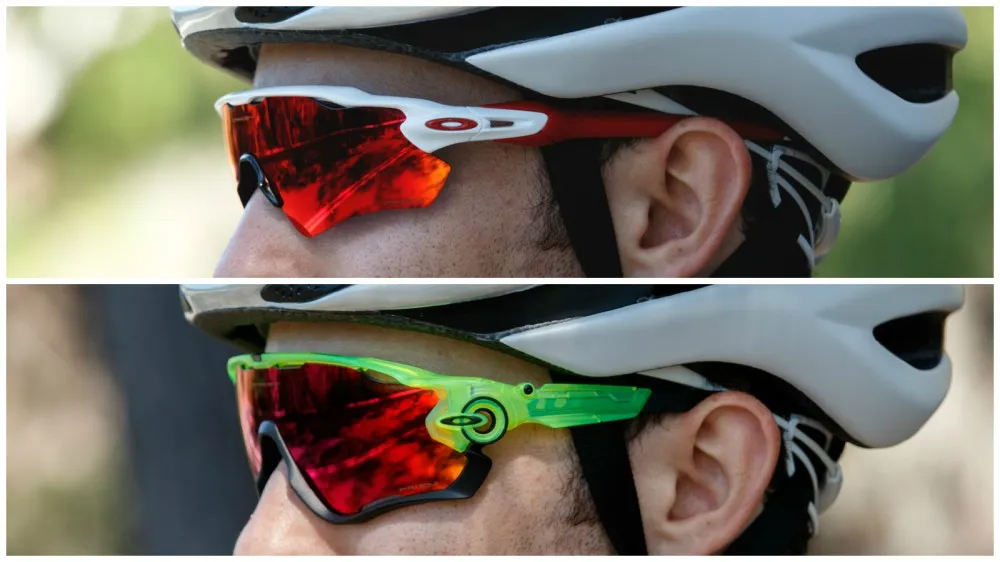
The Radar EV (top) size compared with the Jawbreaker (bottom)
Despite its lower frame, the Jawbreaker’s large lens offers impressive peripheral vision. That said, it’s tough to beat a lack of lower frame and so the Radar EV has the slightest edge when quickly looking back for cars (or your dropped mates).
Additionally, the Radar feels a little breezier at speed – again, not too surprising given the lack of lower frame. Perhaps a better comparison would be with the larger Radar Pitch lens, which is more inline with that of the Jawbreaker’s.
Weighing in at 34g, the Jawbreaker carries a small weight penalty due to its unique features.
Having used both Radar EV and Jawbreaker models, we’d happily use either (both on and off road) so the choice perhaps comes down more to desired style than performance. Pretending that such a decision would be made on more than style alone, if you're looking to replace lenses or want more control over the arm fit then the Jawbreaker is the better option. Otherwise, the simpler and lighter construction of the Radar EV is something that many will appreciate.
Prizm
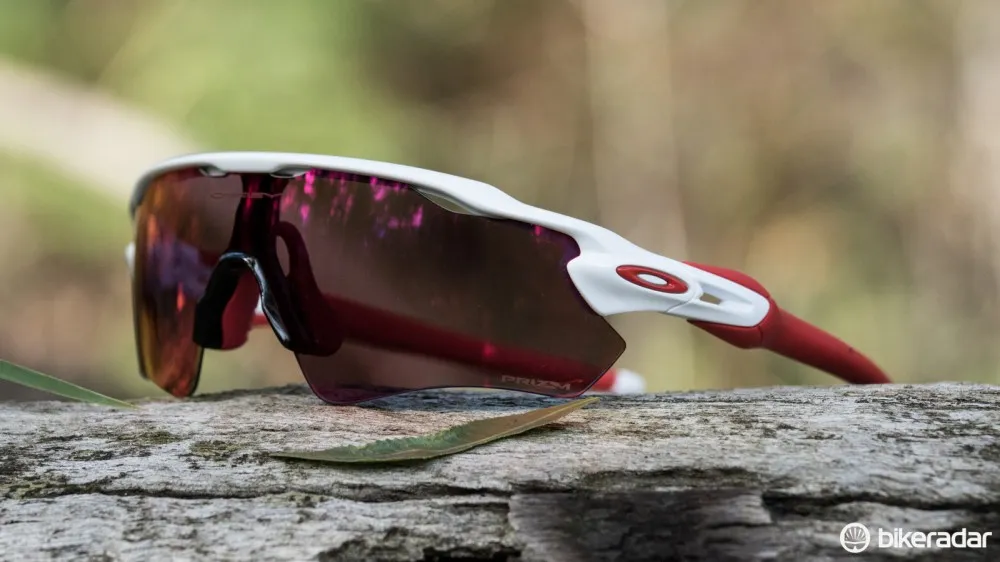
Pictured is the Prizm Road lens
We’ve praised the fit of the Oakley Radar EV glasses, but it’s the Prizm lens that perhaps makes these some of the very best cycling sunglasses we’ve used. Where traditionally a lens is picked based on the light conditions, the Prizm lenses are individually tailored to a specific sport – whether that is skiing, golf, baseball, road cycling or mountain biking – with the latter two disciplines each offering a lens.
Designed specifically for road cycling, the Prizm Road lens is claimed to boost road texture, painted lines, and traffic lights while also enhancing greens and blues. We found our vision generally crisper and road hazards more visible; although the 20 percent light transmission blocked out a little too much for low light use.
Hitting the trails with the Prizm Trail lens is an even more impressive experience, where the red and brown boosting lens allows you to easily pick out obstacles and adapt between sunny and shaded conditions. It's simply the best vision we've experienced when riding rough and technical trails.
In contrast to our experiences with the Prizm Road, the Trail's 36 percent light transmission left us wanting a darker lens for bright sunny days on shadeless trails. These are certainly best suited to shaded and forested trails, as opposed to open desert riding, for instance.
The negative of a discipline-specific as opposed to a light condition-specific lens is that it doesn’t allow for much crossover. Using the Prizm Road lens while mountain biking produced a cold and dark feel, with trail obstacles such as rocks and sticks harder to pick out. In reverse, the Prizm Trail lens on the road provides a slightly brown tint to everything and was just too bright for our liking against the sun-reflecting tarmac.
It’s not like riding one lens in the opposite terrain will cause you to crash, but visibility is compromised nonetheless and we found ourselves straining to make out the conditions ahead. If you regularly do evenly split mixed-surface rides, you may not find a suitable balance with either Prizm lens. Here, a more traditional lens picked based on light conditions is likely the best compromise.
The other option of course, if you own both mountain and road bikes, will be to purchase a second lens. This may be enough to turn away a few users… especially given we’re talking Oakley prices.
It's also worth reiterating that the Jawbreaker glasses are probably a better option if you do want to regularly change lenses. The Radar EVs don’t offer the ‘Switchlock’ mechanism introduced to the Radarlocks, and so still require a little nervous – and sometimes forceful – fiddling to swap a lens.
Something that we've reported on previously is that Oakley now only provides its 'Hydrophobic' coating to the outside part of the lens. Those that sweat a lot will find this a nuisance, as this tends to smear the inside part of the glass, rather than beading and clearing itself like Oakley's of a few years ago. However, as already mentioned, the Radar EV's do breathe better and so it's less of an issue compared to previous generation Radar's.
Despite these niggles, for us the new Radar EVs and Jawbreakers have between them set a new benchmark in cycle eyewear. Assuming you prefer the simpler frameless style, they fit you, the price doesn’t offend your budget, and the potential discipline limitations aren’t an issue, then the new Oakley Radar EV Prizm sunglasses will absolutely not disappoint.
Note: While we tested the Prizm models, it’s worth mentioning that the Radar EV’s are available with a range of standard and polarized lenses too. Although, light-adjusting photocromic lenses are not yet offered.
Since writing this, the Oakley Radar EV Prizm has been selected for a 2015 BikeRadar Editor's Pick Award - see more here.
